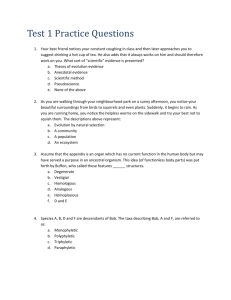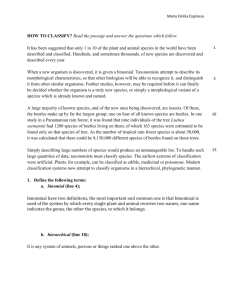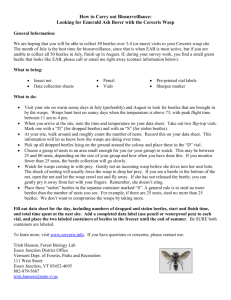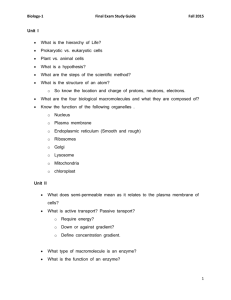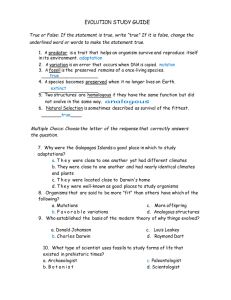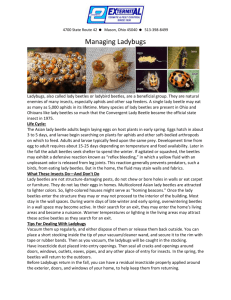BY123 SI Mock Exam
advertisement
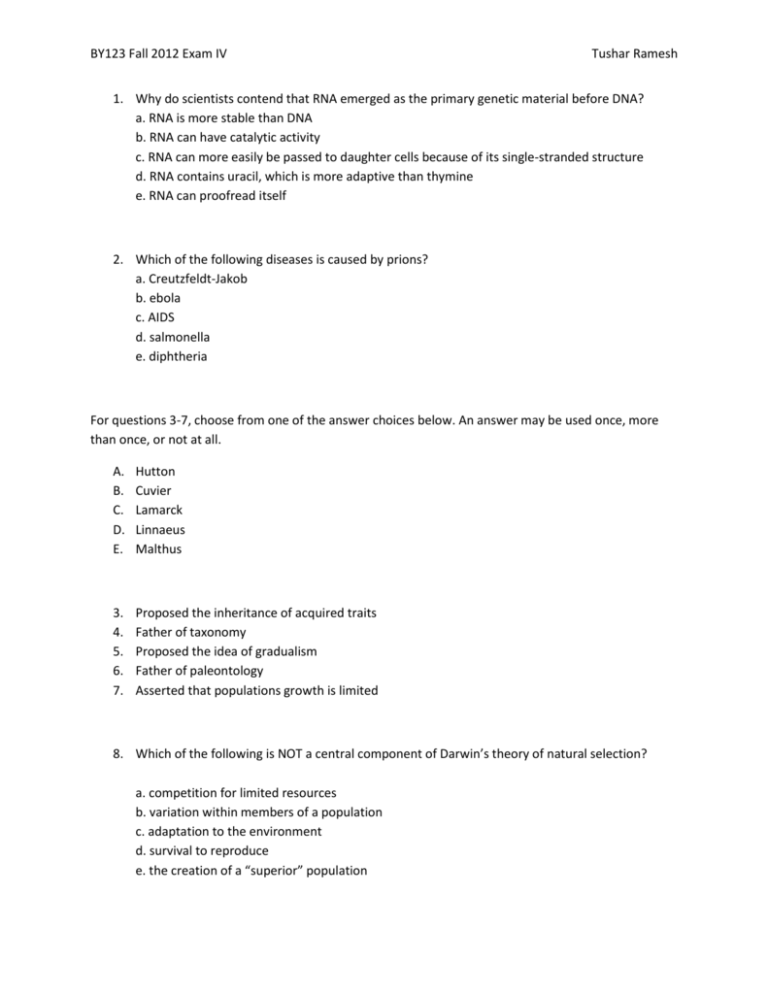
BY123 Fall 2012 Exam IV Tushar Ramesh 1. Why do scientists contend that RNA emerged as the primary genetic material before DNA? a. RNA is more stable than DNA b. RNA can have catalytic activity c. RNA can more easily be passed to daughter cells because of its single-stranded structure d. RNA contains uracil, which is more adaptive than thymine e. RNA can proofread itself 2. Which of the following diseases is caused by prions? a. Creutzfeldt-Jakob b. ebola c. AIDS d. salmonella e. diphtheria For questions 3-7, choose from one of the answer choices below. An answer may be used once, more than once, or not at all. A. B. C. D. E. Hutton Cuvier Lamarck Linnaeus Malthus 3. 4. 5. 6. 7. Proposed the inheritance of acquired traits Father of taxonomy Proposed the idea of gradualism Father of paleontology Asserted that populations growth is limited 8. Which of the following is NOT a central component of Darwin’s theory of natural selection? a. competition for limited resources b. variation within members of a population c. adaptation to the environment d. survival to reproduce e. the creation of a “superior” population BY123 Fall 2012 Exam IV Tushar Ramesh 9. Which of the following correctly lists taxonomic groupings in order of decreasing inclusiveness? a. domain, order, class, genus, species b. domain, kingdom, class, family, genus c. phylum, domain, class, genus, species d. species, genus, family, phylum, domain e. kingdom, phylum, class, species, genus 10. Which of the following pairs of structures are least likely to represent homology? a. the wing of a bat and the fin of a whale b. the thumb of a chimp and the thumb of a human c. the claws of a hawk and the claws of a lizard d. the eye of a squid and the eye of a human e. the brain of a turkey and the brain of a chicken 11. All of the following are differences between prokaryotic and eukaryotic flagella EXCEPT a. prokaryotic flagella lack the 9 + 2 arrangement of chromosomes b. prokaryotic flagella are not membrane bound c. prokaryotic flagella are attached to a basal apparatus d. eukaryotic flagella contain flagellin e. none of the above 12. Which of the following is NOT true of the lysogenic cycle of viral reproduction? a. viral DNA is incorporated into host DNA b. the host cell does not die immediately c. descendants of infected host cells contain viral DNA d. the viral DNA can remain dormant for long periods of time e. the virus quickly takes control over host cell enzymes 13. The smallest unit capable of evolution is the a. species b. individual c. population d. ecosystem e. gene BY123 Fall 2012 Exam IV Tushar Ramesh 14. Which of the following provides the best example of directional selection? a. in a certain population of finches, very large beaks and very small beaks, but not mediumsized beaks, are the most effective for obtaining food b. medium-sized fish, but not very large or very small fish, are the fastest swimmers when chasing their prey c. gray beetles, but not black or white beetles, are the best at hiding from birds on rocks d. white flowers and red flowers are more easily spotted by pollinating birds than pink flowers e. in the tundra, the lightest colored hares are able to hide more effectively from predators than grey or black hares 15. All of the following can contribute to diversity within a population EXCEPT a. crossing-over b. law of independent assortment c. genetic recombination d. binary fission e. sexual reproduction 16. Which of the following provides the best explanation for the development of antibiotic-resistant strains of bacteria? a. antibiotics accelerate the frequency of crossing-over in bacteria b. those few mutant bacteria which survive antibiotic treatments produce offspring that are also resistant to the antibiotic c. F- bacteria confer antibiotic resistance to F+ bacteria d. F- bacteria confer antibiotic resistance to Hfr bacteria e. bacteria can enter the lysogenic cycle to avoid antibiotic treatments 17. Bergman’s rule explains which of the following observations a. polar bears have smaller tails than grizzly bears b. species play a unique role in their environment to avoid direct competition c. the best adapted organisms are the most reproductively successful d. finches with large beaks are better able to eat seeds than finches with small beaks e. rabbits in the tundra are much larger than rabbits in South America 18. Which of the following would be an example of temporal reproductive isolation? a. bird species with different mating times during the year BY123 Fall 2012 Exam IV Tushar Ramesh b. two species of monkeys that are separated by a large river c. different species that cannot fuse their sperm and eggs d. two species that reproduce to form a hybrid that does not survive long after birth e. two different species that cannot reproduce because of their different mating rituals 19. Which type of reproductive isolation requires the greatest expenditure of energy in order to separate different species? a. habitat isolation b. temporal isolation c. reduced hybrid viability d. hybrid breakdown e. mechanical isolation 20. Which of the following would be an example of autopolyploidy? a. the fusion of two species with different chromosome numbers to form hybrid offspring b. the separation of a species by a geographic barrier c. nondisjunction in a species that produces descendants with twice as many chromosomes d. the fusion of chromosomes in one species that produces offspring with fewer chromosomes e. the fusion of several sperm with one egg to produce descendants with multiple sets of chromosomes 21. A population of birds is geographically separated when part of the continent broke off from the mainland. After hundreds of thousands of years, this part of the continent drifted back to the mainland, and the original population of birds was reintroduced to the population that was separated generations ago. Which of the following, if true, would provide the strongest evidence that these two populations now belong to different species? a. the two populations of birds have different coloration patterns b. the two populations of birds are able to mate, and their hybrids are able to live to the age of reproductive maturity c. one of the populations builds more of its nests on the ground than the trees d. the two populations interbreed and produce hybrids, but when these hybrids mate, the offspring are sterile e. one population is more successful at avoiding predatory foxes than the other population 22. Which of the following evolutionary mechanisms facilitated the domination of mammals in many different environments? BY123 Fall 2012 Exam IV Tushar Ramesh a. allopolyploidy b. adaptive radiation c. autopolyploidy d. allopatric speciation e. the bottleneck effect 23. All of the following are important mechanisms for macroevolution EXCEPT a. paedomorphosis b. heterochrony c. homeotic genes d. founder effect e. duplication of Hox genes 24. Which of the following is a problem with the gradualist model of evolution? a. gradualism contradicts Darwin’s theory of natural selection b. evolutionary changes cannot have occurred slowly because the earth is not nearly old enough c. populations do not adapt to the environment gradually d. gradual changes could never have occurred in geological records e. it’s difficult to find transitional species because of the huge gaps in fossil records 25. Plant species A and plant species B produce a viable hybrid species C by means of allopolyploidy. If species A has a diploid number of 10 chromosomes, and species B has a diploid number of 6 chromosomes, what will the diploid number of chromosomes in species C? a. 2n = 4 b. 2n = 8 c. 2n = 12 d. 2n = 16 e. 2n = 32 26. Scientists estimate the earth to be approximately how many years old? a. 5.5 billion b. 4.6 billion c. 3.5 billion d. 500 million e. 60,000 BY123 Fall 2012 Exam IV Tushar Ramesh 27. Which of the following best explains the vast diversity of dog breeds belonging to the same species? a. artificial selection b. natural selection c. autopolyploidy d. genetic drift e. high frequency of mutation 28. The Permian extinction a. has been linked to a meteor explosion b. resulted in the death of about ninety percent of marine species c. probably resulted from the mass eruption of volcanoes d. likely caused the extinction of the dinosaurs e. destroyed about half of the terrestrial species 29. Liposomes were likely important in which of the following macroevolutionary stages of life? a. abiotic synthesis b. formation of macromolecules c. emergence of DNA d. probiotic synthesis e. propagation of genetic material 30. During transduction a. Hfr cells transmit part of their chromosomal DNA to other cells b. F+ cells transfer plasmids to F- cells c. genetic material from the surrounding environment is absorbed by prokaryotic cells d. phages transfer genetic material from one prokaryotic cell to another e. sex pili allow the transfer of genetic material between prokaryotes Use the information below to answer questions 31 to 34. In a certain population of mice that is in a state of Hardy-Weinberg equilibrium, there are two alleles that code for fur color. The allele coding for black fur exhibits a simple dominant relationship over the allele coding for white fur. The allele for black fur occurs with a frequency of 0.60 in this mice population. 31. What is the frequency of the allele that codes for white fur? BY123 Fall 2012 Exam IV Tushar Ramesh a. 0.16 b. 0.24 c. 0.36 d. 0.40 e. 0.60 32. What percentage of the mice would be expected to have white fur? a. 16% b. 24% c. 36% d. 48% e. 60% 33. What percentage of the mice would be expected to have black fur? a. 16% b. 24% c. 48% d. 72% e. 84% 34. What percentage of the mice would be expected to be heterozygous at the locus for fur color? a. 16% b. 24% c. 48% d. 72% e. 84% Questions 35–37 A large population of laboratory animals has been allowed to breed randomly for a number of generations . After several generations, 49 percent of the animals display a recessive trait (bb), the same percentage as at the beginning of the breeding program . The rest of the animals show the dominant phenotype, with heterozygotes indistinguishable from the homozygous dominants . 35. What is the most reasonable conclusion that can be drawn from the fact that the frequency of allele b has not changed over time? BY123 Fall 2012 Exam IV Tushar Ramesh (a) The population is undergoing genetic drift. (b) The two phenotypes are equally adaptive under laboratory conditions. (c) The genotype BB is lethal. (d) There has been a high rate of mutation of allele B to allele b . (e) There has been sexual selection favoring allele b . 36. What is the frequency of allele b in the gene pool? (a) 0 .70 (b) 0 .51 (c) 0 .49 (d) 0 .30 (e) 0 .07 37. What proportion of the population is heterozygous (Bb) for this trait? (a) 0 .51 (b) 0 .42 (c) 0 .21 (d) 0 .09 (e) 0 .07 Questions 38-40 Individuals of a particular species of ground beetle are either light tan or dark brown. Light-tan beetles are predominant in habitats with light-colored sandy soils, and dark brown beetles are predominant in habitats with dark-colored loam soils. In an experiment designed to determine the survival rates of light-tan beetles and dark brown beetles in different habitats, 500 light-tan beetles and 500 dark-brown beetles were released in each of four habitats. Each beetle had been marked with a small spot of red paint on the underside of its abdomen before it was released. One week after the beetles had been released, any marked beetles that could be found were recaptured. The results are presented in the table below. It is assumed that differences in the numbers of beetles recaptured are directly related to differences in survival rates. Habitat 1 Sandy soil, no insectivorous birds present Light Dark Tan Brown 500 500 Color Of Beetle Number Released Number 130 Recaptured 114 Habitat 2 Sandy soil, insectivorous birds present Light Dark Tan Brown 500 500 Habitat 3 Loam soil, no insectivorous birds present Light Dark Tan Brown 500 500 Habitat 4 Loam soil, insectivorous birds present Light Dark Tan Brown 500 500 123 65 13 22 74 38. Which of the following processes best explains why fewer light-tan beetles than 87 BY123 Fall 2012 Exam IV Tushar Ramesh dark-brown beetles were recaptured in habitat 4? (a) Founder effect (b) Genetic drift (c) Mutation (d) Adaptive radiation (e) Natural selection 39. If all insectivorous birds and remaining beetles were removed from habitat 2 and 500 additional dark-brown beetles and 500 additional light-tan beetles were then released into habitat 2, which of the following is the best estimate of the number of additional dark-brown beetles that would be expected to be recaptured in habitat 2 after one more week? (a) 0 (b) 22 (c) 120 (d) 220 (e) 500 40. Which of the following can be inferred from the data in the table? (a) Ground beetles do not emigrate from the habitat in which they live. (b) Insectivorous birds prefer to eat light-tan beetles rather than dark-brown beetles. (c) Ground beetles have higher rates of survival in habitats with loam soil. (d) Insectivorous birds are predators of this species of ground beetle. (e) The reproductive success of beetles in habitats with sandy soils is greater than that of beetles in habitats with loam soils 41. Which of the following statements best summarizes the theory of evolution as it is viewed by modern biologists? (a) It is goal directed. (b) It represents the results of selection for acquired characteristics. (c) It is synonymous with the process of gene flow. (d) It is the descent of humans from the present-day great apes. (e) It is the differential survival and reproduction of certain phenotypes. 42. What does recent scientific evidence suggest about the origin of mitochondria and chloroplasts? a. these organelles are probably descended from prokaryotes that lived within larger cells b. mitochondria descended from ribosomes, and chloroplasts likely descended from endoplasmic reticula c. mitochondria and chloroplasts were at one point viruses that infected prokaryotic cells d. the infoldings of parts of the prokaryotic cell wall eventually developed into mitochondria and chloroplasts BY123 Fall 2012 Exam IV Tushar Ramesh e. mitochondria were probably small animal cells, and chloroplasts were probably early plant cells 43. Which of the following represents the correct order of events in the reproductive cycle of HIV? I. viral DNA is incorporated as a provirus into the host cell DNA II. glycoproteins on the surface of the virus allow it to enter the host cell III. proviral mRNA molecules are used to translate proteins for new viruses IV. proviral genes are transcribed mRNA molecules V. reverse transcriptase converts viral RNA into DNA a. b. c. d. e. II, III, IV, V, I II, V, IV, III, I II, V, I, IV, III II, V, IV, I, III II, III, V, I, IV 44. All of the following reduce genetic diversity within a population EXCEPT a. founder effect b. bottleneck effect c. genetic drift d. balancing selection e. natural selection 45. Which of the following is NOT a difference between prokaryotic and eukaryotic cells? a. prokaryotic cells have circular DNA, but eukaryotic cells have linear DNA b. prokaryotic cells are always unicellular, but eukaryotic cells can be either unicellular or multicellular c. prokaryotic have cell walls, but eukaryotes do not d. prokaryotic cells, unlike eukaryotic cells, lack membrane-bound organelles e. eukaryotic cells, but not prokaryotic cells, undergo mitosis 46. Which of the following is true about bacterial conjugation? a. F- cells generate cell pili b. Hfr cells can induce F- cells to become partially diploid by transferring part of their chromosome to F- cells c. F+ cells transfer part of their chromosome to F- cells and thereby induce them to become F+ d. Hfr cells can only conjugate with F+ cells e. Hfr cells result when the F plasmid duplicates and incorporates its copy into the main chromosome BY123 Fall 2012 Exam IV Tushar Ramesh 47. Which of the following is common to both viruses and prokaryotic cells? a. cell membrane b. rapid growth c. genetic material in the form of nucleic acids d. ribosomes e. glycolysis 48. Which of the following contribute to genetic diversity in prokaryotic populations? I. meiosis II. binary fission III. mutation IV. transformation a. II only b. III only c. I and III only d. III and IV only e. II, III and IV 49. The heterozygote advantage a. maintains genetic diversity within a population b. can explain why genes for sickle-cell anemia are prevalent in certain African populations c. favors multiple alleles at a locus d. a and b only e. all of the above 50. Which of the following is NOT a reason why natural selection fails to produce perfect organisms? a. evolution is bound by historical constraints b. random chance can interfere with natural selection c. natural selection requires much more time to produce perfect organisms d. many adaptations often come at the expense of other advantages e. natural selection can only modify variations that already exist within a population
